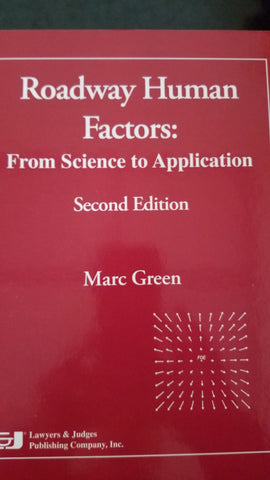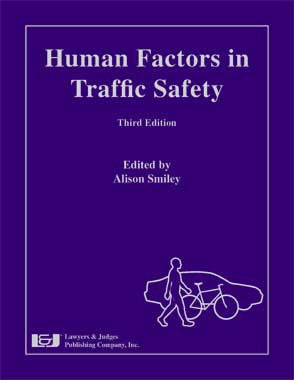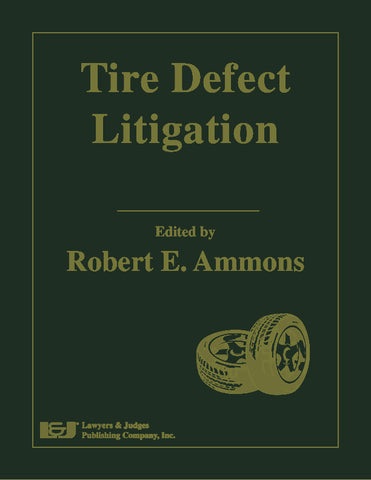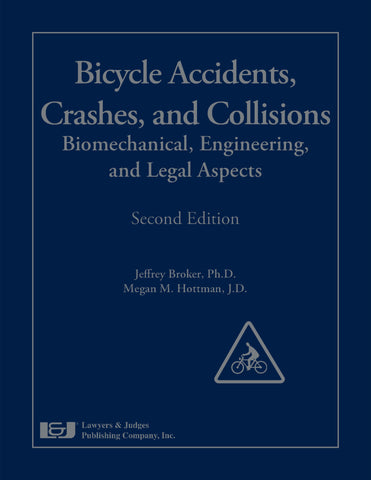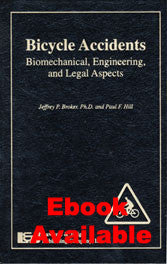
Bicycle Accidents: Biomechanical, Engineering, and Legal Aspects
This book is available as a Kindle eBook. Click here to purchase and download:
- Author: Jeffrey P. Broker, Paul F. Hill; Contributors: Bernard S. Abrams, Jerry Eubanks, W. R. "Rusty" Haight, David A. Mitchell, Ross D. Petty, Leslie Weintraub,
- ISBN 10: 0-913875-90-2
- ISBN 13: 978-0-913875-90-2
- Copyright Date Ed: June 15, 2006
- Pages: 592
- Binding Information: Casebound
- Size: 6 ✕ 9 Inches (US)
With this book you will learn about many different aspects of bicycle accidents and the legal issues surrounding them. The authors, who between them have over twenty years experience investigating bicycle accidents, present a wealth of information including such topics as the physical and operating characteristics of bicycles, cyclist's rights and duties, accident types, insurance and liability issues and bicycle regulatory information, including the Uniform Vehicle Code and State Bicycle Statutes.
The book is divided into two parts for easy access to pertinent information. Part one discusses many of the physical and mental aspects of operating a bicycle. You will learn about topics such as the cycling setting, crash tests, bicycle types and designs, visual perception and response, equipment failure, and biomechanics of cycling injuries. Part two covers the legal aspects of operating a bicycle and of liability, both of the cyclist and others such as pet and property owners. This section provides information on a wide variety of topics including releases or waivers of liability, common accident types including accidents involving dogs, product defects and liability, and cycling setting defects and liability. Bicycle regulatory information is also covered in greater detail in this section.
If you are handling a bicycle accident case, this book is a necessary addition to your library.
Table of Contents
Part One
Introduction to Part One
Chapter 1: Bicycle Types, Bicycle Anatomy, and Bicycle Setup
1.1 Bicycles Types
1.2 Bicycle Anatomy
1.3 Bicycle Setup
A. Saddle height
B. Saddle fore-aft position
C. Crank length determination
D. Handlebar placement
Chapter 2: Bicycle Operating Characteristics
2.1 Balance and Steering
A. Normal riding
B. Turning
C. Emergency steering
D. Destabilizing situations
E. Steering geometry, stability, and high speed shimmy
2.2 Bicycle Propulsion
A. Cycling equation of motion
B. Pedal forces
C. Gearing and cadence
2.3 Bicycle Braking
A. CPSC braking requirements for bicycle
B. Limits of braking and pitchover phenomenon
C. General guidelines for braking
Chapter 3: The Cycling Setting
3.1 Where Cyclists Ride
3.2 Cycling Statistics: Use Patterns and Categorizing Accidents
3.3 Cycling on the Road: Characteristics that Affect Bicycle Traffic Patterns
A. Bicycles as vehicles and three "special" rules for cyclists
B. Where to generally ride on roads, and what is "practicable"
C. Managing parked cars
D. Intersections
E. Gutters, seams, railroad tracks, grates and various sharp edges
3.4 Staying Alive on the Roads versus Accident Causation Analysis
Chapter 4: Principles of Bicycle Accident Reconstruction
4.1 Identifying the Critical Questions and Issues
4.2 Comprehensive Fact Gathering: Assembling the Puzzle Pieces
A. Accident reporting
B. Witness accounts
C. Physical evidence
D. Injury profiles
E. The accident scene
F. Supporting technical analyses
4.3 Summary of Accident Investigation Principles
Chapter 5: Crash Tests Involving Bicycles and Motor Vehicles
5.1 Test Methods
5.2 Test Results
5.3 Video and film documentation
A. Initial contact and wrap characteristics
B. Airborne trajectories
C. Motor vehicle damage
D. Bicycle damage profiles
5.4 Using Pedestrian Throw Formulas to Analyze Bicyclist/Motor Vehicle Collisions
A. Throw formulas
B. Application of the formulas to cyclist/motor vehicle collisions
5.4 Conclusion
Chapter 6: Cycling Injuries: Biomechanics, Frequency, and Form
6.1 Injury Defined
6.2 Anatomical Planes and Directions
6.3 Acute versus Chronic Injuries
6.4 Specific Tissues Involved In Injury
A. Injuries to the skin
B. Injuries to bone and cartilage
C. Injuries to muscle, tendon, and ligament
D. Injuries to joints
E. Injuries to nerves
6.5 Injury Profiles in Cycling
A. Epidemiology
B. Injury mechanisms in specific cycling accidents
Chapter 7: Visual Behavior as Related to Bicycle Riders
7.1 Methodology
A. How the human visual system functions
B. Other components of vision
7.2 Driver Visual Needs
A. Visual needs to discern bicyclists
B. The bicycle must be conspicuous
7.3 Visual Perception Related To Driving
A. Distance clues
B. Velocity judgments
C. Illumination clues
D. Atmospheric clues
7.4 Human Factors of Warning Devices
A. Human factors
B. Perception reaction
C. Brain versus computers
D. Warning devices of the future
E. Commentary
7.5 Why Traffic Control Devices for Bicyclists?
A. Vehicle operators belief
B. Bicyclists belief
C. Commentary
7.6 Sun Glare—Daylight Problems
B. Roads
7.7 Conclusion
Appendices
Chapter 8: Safety Standards and Regulations in the Bicycle Industry
8.1 Regulations versus Standards
A. History
B. The differences between regulations and standards
8.2 The United States versus the World
A. United States influence in the world
B. World influence in the United States
8.3 Conclusions
Chapter 9: Bicycle Materials and Failure Mechanisms
9.1 History of Frame Materials
9.2 Modern Bicycle Design
A. Typical types of bicycles and their uses
B. Market position within types and uses of bicycles
9.3 Modern Materials of Frame Construction
A. Steel
B. Aluminum
C. Titanium
D. Composite materials
E. Comparison of materials
9.4 Modern Methods of Frame Manufacture
A. Brazing
B. Welding
C. Adhesive bonding
D. Composite frame building
9.5 Modern Materials of Component Manufacture
9.6 Failure Modes in Modern Designs
A. Mechanical overload
B. Stress concentration and surface defects
C. Fatigue
D. Corrosion
9.7 Failure Analysis Techniques
A. Visual examination
B. Dimensional measurement
C. Material identification
D. Mechanical properties
E. Metallographic examination
F. Fracture surface analysis
G. Techniques in non-metallic materials
9.8 Failure Avoidance
9.9 Conclusion
Part Two
Introduction to Part Two
Chapter 10: Cyclist’s Rights and Duties
10.1 Maintaining a Proper Lookout
10.2 Right to Use the Road, Choice of Route, and Assumption of the Risk
10.3 Riding as Near to the Right as Practicable
10.4 Two Abreast or Single File
10.5 Riding Double, Tandems, and Imputed Negligence
10.6 Equipment Requirements: Helmet Laws
10.7 Equipment Requirements: Lights and Reflectors
10.8 Equipment Requirements: Bell or Horn
10.9 Riding Under the Influence of Alcohol or Drugs
Chapter 11: Intersection Accidents
11.1 Failure of Bicycle to Trip Signal
11.2 Driver Turning Left
11.3 Driver Passing or Meeting and Turning Right
11.4 Intersections with no Traffic Signs or Signals
11.5 Intersections with Stop Signs
11.6 Intersection with Traffic Signals
11.7 Cyclist Making Left Turn
11.8 Cyclist on Favored Street
11.9 Cyclist on Disfavored Street
11.10 Cyclist Entering or Crossing Roadway at Other than Intersection
11.11 Cyclist and Motor Vehicle Meeting, Including Wrong-Way Cyclist
11.12 Projecting Loads and Mirrors
11.13 Driver Opening Door into Path of Cyclist
11.14 Motor Vehicle Backing
11.15 Cyclist on Sidewalk, Crosswalk, Bicycle Lane or Path
Chapter 12: Cyclist in Collision with Bicycle or Pedestrian
12.1 Bicycle-Bicycle Collisions
12.2 Bicycle-Pedestrian Collisions
Chapter 13: Accidents Caused by Dogs
13.1 Background
13.2 Common Law and Statutes
13.3 Cases
13.4 Points to Remember
A. For the cyclist
B. For the attorney
Chapter 14: Accidents Caused by Defects in Street, Highway, Sidewalk, Path, Private Property, or Recreational Land
Chapter 15: Products Liability
15.1 Introduction
15.2 Brakes
15.3 Helmets
15.4 Grates
15.5 Frame and Fork
15.6 Toe Clips and Pedals
15.7 Lights and Reflectors
15.8 Negligent Assembly or Maintenance
15.9 Wheel Retention
15.10 Other product liability cases
Chapter 16: Insurance Considerations
16.1 Introduction
16.2 "Through Being Hit By" and "Physical Contact" Construed
16.3 Uninsured/Underinsured and Hit-and-Run Coverage
16.4 No-Fault Automobile Insurance
16.5 Homeowners or Renters Personal Liability Coverage
Chapter 17: Signed Releases of Liability (Waivers)
17.1 Introduction
17.2 Cases
17.3 Concluding Remarks
Chapter 18: The Uniform Vehicle Code and State Bicycle Statutes
18.1 Introduction
18.2 Selected Uniform Vehicle Code Bicycle Provisions
18.3 Synopsis of State Statutes
Chapter 19: Regulatory Standards
19.1 Introduction
19.2 Historical Overview of Bicycle Safety Standards
19.3 General Product Safety Requirements
A. Handlebars and steering system
B. Brakes
C. Audible warning devices
D. Nighttime equipment
19.4 Bicycle Helmet Safety Standards
19.5 Bicycle Advertising Safety Requirements

